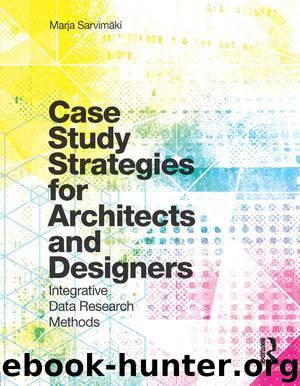Case Study Strategies for Architects and Designers: Integrative Data Research Methods by Marja Sarvimaki

Author:Marja Sarvimaki [Sarvimaki, Marja]
Language: eng
Format: azw3
ISBN: 9781317480617
Publisher: Taylor and Francis
Published: 2017-06-27T04:00:00+00:00
Interviews, then, can provide you with either quantitative or qualitative data depending on the goal of your inquiry and how your questions are articulated. As a reminder, you should have an analytic strategy prior to data collection, which with regard to interviews means that you have a plan on how to analyze and interpret the answers. An interview with a structured format would, ideally, give you quantitative information easy to evaluate, like number of desired rooms, size of teams in an office setting, future functions and their dimension requirements, and suchlike. In design research, these kind of interviews would be typical in the programming stage, revealing the needs and expectations of the future users; for example, as a part of data collection in a Pre-Occupancy Evaluation. Or, interviews can be part of a Post-Occupancy Evaluation with the goal of finding out how a building is performing (e.g., in comparison to the Pre-Occupancy Evaluation) which can guide similar design solutions in the future. In the context of urban planning, the data could include what percentage of residents prefer one feature over another, how many residents support and how many oppose a proposed change, and other statistical inquiries included in your case study protocol. In other words, the results would be rather similar to that acquired with a questionnaire, just with a different response format, because the data is obtained by talking with the respondents of the study; this, of course, means that attaining quantitative data with interviews is doable only with somewhat small groups of respondents. Conversely—as anyone involved with design knows—the users themselves are not always aware of the prospects of a project or a setting. An unstructured interview could, thus, shed more light into their perception of the case and provide in-depth information, of which even the participants of a study themselves might not be aware. As this method has many advantages, but also pitfalls, we continue examining open-ended interviews in the context of fieldwork on pp. 91–5.
Besides questionnaires and interviews, we can obtain data by direct observations, mapping, sorting, or equivalent evaluations of a real-world setting. Direct observations range from casual accounts of a context—or its sense of place, if you wish—to formal numeric data of it. For example, William Whyte’s correlational study, answering why some public places in New York City were more popular than others, was based on counting the number of people in certain plazas at lunch hours and comparing that data with the amount of sitting linear feet and the size of open area, to summarize the quantitative data of this extensive study very succinctly. Another case study covered by Groat and Wang is Kevin Lynch’s renowned investigation The Image of a City, based on mapping. In it, the participants of the study were asked to draw rough maps of their city (Boston, New Jersey, and Los Angeles), after which the researchers produced composite maps juxtaposing the drawings. The visual analysis revealed a high positive correlation in the residents’ perceptions of the characteristics of
Download
This site does not store any files on its server. We only index and link to content provided by other sites. Please contact the content providers to delete copyright contents if any and email us, we'll remove relevant links or contents immediately.
| Automotive | Engineering |
| Transportation |
Whiskies Galore by Ian Buxton(41519)
Introduction to Aircraft Design (Cambridge Aerospace Series) by John P. Fielding(32880)
Small Unmanned Fixed-wing Aircraft Design by Andrew J. Keane Andras Sobester James P. Scanlan & András Sóbester & James P. Scanlan(32565)
Craft Beer for the Homebrewer by Michael Agnew(17922)
Turbulence by E. J. Noyes(7688)
The Complete Stick Figure Physics Tutorials by Allen Sarah(7133)
Kaplan MCAT General Chemistry Review by Kaplan(6581)
The Thirst by Nesbo Jo(6430)
Bad Blood by John Carreyrou(6266)
Modelling of Convective Heat and Mass Transfer in Rotating Flows by Igor V. Shevchuk(6217)
Learning SQL by Alan Beaulieu(6022)
Weapons of Math Destruction by Cathy O'Neil(5815)
Man-made Catastrophes and Risk Information Concealment by Dmitry Chernov & Didier Sornette(5637)
Digital Minimalism by Cal Newport;(5375)
Life 3.0: Being Human in the Age of Artificial Intelligence by Tegmark Max(5179)
iGen by Jean M. Twenge(5148)
Secrets of Antigravity Propulsion: Tesla, UFOs, and Classified Aerospace Technology by Ph.D. Paul A. Laviolette(4971)
Design of Trajectory Optimization Approach for Space Maneuver Vehicle Skip Entry Problems by Runqi Chai & Al Savvaris & Antonios Tsourdos & Senchun Chai(4836)
Electronic Devices & Circuits by Jacob Millman & Christos C. Halkias(4738)
